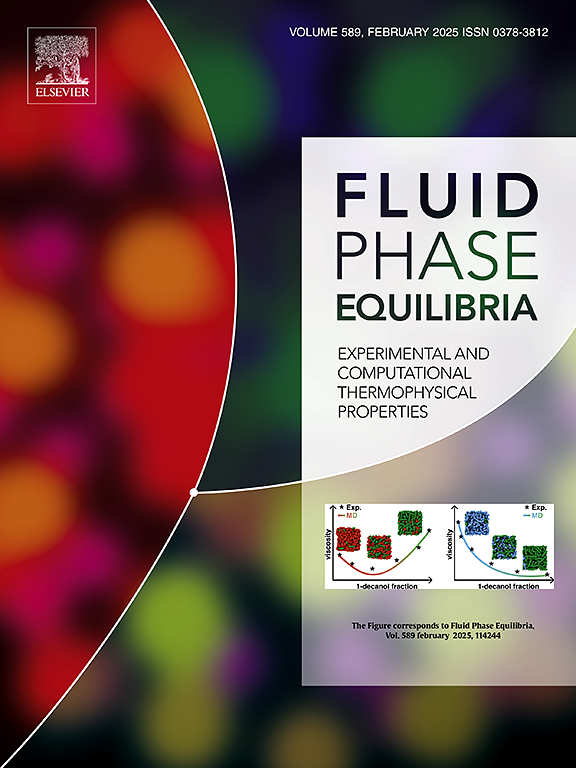含氯化胆碱体系固液平衡的UNIFAC参数化
IF 2.7
3区 工程技术
Q3 CHEMISTRY, PHYSICAL
引用次数: 0
摘要
在文献中,氯化胆碱被广泛用于制备共晶溶剂,用于从不同原料中提取生物化合物。共晶溶剂的配制应通过对混合物的固液平衡(SLE)的评价和共晶点的确定来进行。在这种情况下,通过热力学建模计算共晶点可以改进萃取过程溶剂的设计。UNIFAC模型是一个基于群体贡献的模型,可以在这种情况下使用。在此背景下,本研究旨在调整新的原始UNIFAC相互作用参数对(amand anm),以氯化胆碱[Ch]Cl(本文将其作为伪基团)和CH3 (Ch, CH2和CH3亚基团),OH和COOH基团。建立了一个由不同文献中SLE实验数据组成的数据库。该数据集包括23种[Ch]Cl与多元醇、多羧酸、长链羧酸(脂肪酸)和长链醇(脂肪醇)混合物的完整SLE数据。调整后的参数在描述混合物的SLE分布方面具有显著的准确性,特别是在富含[Ch]Cl的区域,平均相对偏差从1.32%到10.79%不等。新的UNIFAC焓参数还能以合理的精度预测[Ch]Cl混合物的共晶温度和共晶成分,这对于设计新的共晶溶剂来说是非常有趣的。本研究与绿色化学文献合作,考虑到更快地筛选由氯化胆碱组成的新型DES和ES。本文章由计算机程序翻译,如有差异,请以英文原文为准。
UNIFAC parametrization for solid-liquid equilibrium of systems containing choline chloride
Choline chloride has been extensively used in literature for the formulation of eutectic solvents for the extraction of biocompounds from different raw materials. The formulation of eutectic solvents should be performed through the evaluation of the Solid-Liquid Equilibrium (SLE) of the mixture and identification of its eutectic point. In this case, the eutectic point calculation through thermodynamic modeling could improve the design of solvents for extraction processes. The UNIFAC model is a group-contribution based model that could be used in this case. In this context, this study was aimed at the adjustment of new original UNIFAC interaction parameters pairs (amnand anm) for choline chloride [Ch]Cl (treated in this work as a pseudo-group) and CH3 (CH, CH2 and CH3 subgroups), OH and COOH groups. A databank composed of experimental SLE data from different works in literature were built. The dataset included complete SLE data of 23 mixtures of [Ch]Cl with polyols, polycarboxylic acids, long-chain carboxylic acids (fatty acids) and long chain alcohols (fatty alcohols). Parameters adjusted showed a significant accuracy in describing the SLE profile of the mixtures, especially in the [Ch]Cl rich region, with mean relative deviation varying from 1.32 to 10.79 %. The new UNIFAC enthalpic parameters were also able to predict eutectic temperatures and eutectic compositions of [Ch]Cl mixtures with reasonable accuracy, which is quite interesting considering the design of new eutectic solvents. This study collaborates with the green chemistry literature taking into account the faster screening of new DES and ES composed of choline chloride.
求助全文
通过发布文献求助,成功后即可免费获取论文全文。
去求助
来源期刊

Fluid Phase Equilibria
工程技术-工程:化工
CiteScore
5.30
自引率
15.40%
发文量
223
审稿时长
53 days
期刊介绍:
Fluid Phase Equilibria publishes high-quality papers dealing with experimental, theoretical, and applied research related to equilibrium and transport properties of fluids, solids, and interfaces. Subjects of interest include physical/phase and chemical equilibria; equilibrium and nonequilibrium thermophysical properties; fundamental thermodynamic relations; and stability. The systems central to the journal include pure substances and mixtures of organic and inorganic materials, including polymers, biochemicals, and surfactants with sufficient characterization of composition and purity for the results to be reproduced. Alloys are of interest only when thermodynamic studies are included, purely material studies will not be considered. In all cases, authors are expected to provide physical or chemical interpretations of the results.
Experimental research can include measurements under all conditions of temperature, pressure, and composition, including critical and supercritical. Measurements are to be associated with systems and conditions of fundamental or applied interest, and may not be only a collection of routine data, such as physical property or solubility measurements at limited pressures and temperatures close to ambient, or surfactant studies focussed strictly on micellisation or micelle structure. Papers reporting common data must be accompanied by new physical insights and/or contemporary or new theory or techniques.
 求助内容:
求助内容: 应助结果提醒方式:
应助结果提醒方式:


